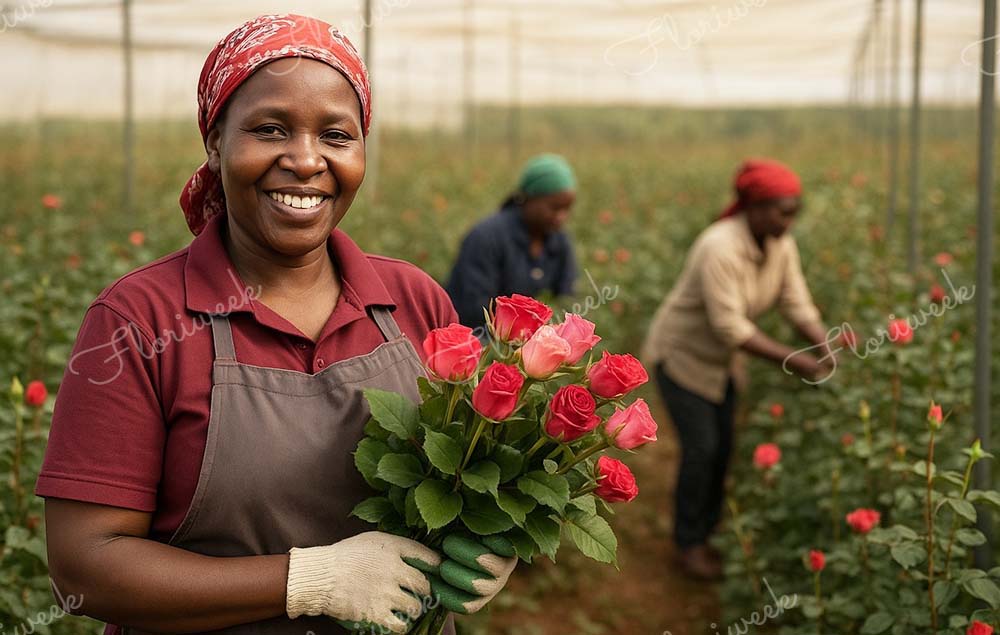
Bʏ Mᴀʀʏ Mᴡᴇɴᴅᴇ

Kenya’s floriculture industry is indeed an important pillar of the country’s economy, ranking among its top foreign exchange earners and providing employment to hundreds of thousands of people. Women form a significant majority of this workforce, estimated at 60 to 75 percent, and hold key responsibilities spanning the entire production continuum, from planting and crop maintenance to harvesting, quality control, and post-harvest processing.
Their roles are critical not only for meeting the demanding quality standards required for international markets but also for sustaining the livelihoods of many families and local communities dependent on the sector.
They perform labour-intensive tasks that require precision and care, particularly in post-harvest handling, sorting, grading, and packaging flowers to meet stringent international quality standards. Research shows that their meticulous handling extends vase life by up to 30 percent, significantly reducing waste and enhancing export value. Their incomes often serve as vital financial support for households, enabling access to healthcare, education, and food security in rural communities. Thus, women’s roles in flower growing transcend the farm gates to broader social and economic impacts in the society.
Persistent Barriers to Land Access and Ownership
A fundamental constraint confronting women small-scale flower producers lies in limited access to land, a critical production asset. Patriarchal land tenure systems, customary inheritance practices, and gender-biased formal land laws have historically marginalized women’s claim to land ownership and control. Without secure land titles or leases, women farmers face insecurity that discourages long-term investment in sustainable flower production and deters access to credit and support services that require proof of land ownership.
Studies in major floriculture regions indicate that many women operate on leased or family land without formal documentation, reducing their autonomy in farm management decisions. The limited control over land also hampers their ability to scale operations, diversify crops, and adopt environmentally sustainable practices that may involve costly inputs or infrastructure investment.
Credit and Financing Constraints for Women Producers
Access to credit remains another significant bottleneck for women in Kenya’s flower sector. Small-scale women growers primarily rely on internally generated funds or informal lending from family and social networks. Formal financial institutions often perceive them as high-risk borrowers due to lack of collateral (linked to insecure land tenure), limited credit history, and smaller-scale operations. Awareness and utilization of gender-responsive financial products tailored for agri-enterprises, though growing, remain insufficient.
The limited credit access restricts women’s ability to invest in quality inputs, pest and disease management, post-harvest technologies, and certification processes that can unlock premium markets. Consequently, many women producers remain confined to low-margin, informal channels with limited ability to scale sustainably.
Limited Access to Training and Capacity Building
Training and technical assistance are critical enablers for adopting best practices that improve yields, quality, sustainability, and workplace safety. However, women farmers often face challenges in accessing such opportunities due to geographic isolation, time poverty driven by household and caregiving responsibilities, and gender-biased extension services that prioritize male farmers and larger estates.
Programs by government agencies, NGOs, and industry bodies have increasingly sought to mainstream gender-responsive approaches, offering tailored training on integrated pest management, water conservation, sustainable production techniques, and leadership. Yet, these initiatives often fall short of reaching the most marginalized women producers due to limited scale and funding constraints.
Decision-Making Power and Gender Dynamics
Despite their numerical dominance in the workforce, women often have limited decision-making power both at the farm level and within industry governance. Traditional gender norms and household dynamics tend to centralize control over productive assets, income, and strategic farm decisions in the hands of male family members or farm owners.
This imbalance affects women’s ability to influence choices related to crop selection, investment priorities, wage negotiations, and certification compliance. In formal employment settings, women workers often occupy lower-tier positions with little voice in workplace policies, wage structures, or career advancement opportunities. Gender-disaggregated data show slower progress in women’s representation in supervisory or managerial roles within flower farms.
Occupational Health, Safety, and Working Conditions
Women workers frequently face hazardous working conditions, including exposure to agrochemicals, repetitive manual labour, and long working hours with limited breaks. Studies reveal that women are disproportionately affected by health and safety risks due to physiological vulnerability and inadequate provision of protective gear tailored to their needs.
Sexual harassment, discrimination, and unequal pay also persist in parts of the sector despite ongoing social audits and compliance efforts prompted by ethical sourcing demands from global buyers. Contractual insecurity, characterized by short-term and casual employment arrangements, further undermines women’s job stability and access to benefits.
Social and Policy Interventions Addressing Women’s Challenges
The Kenyan government, flower industry bodies like the Kenya Flower Council, trade unions, NGOs, and global buyers have taken steps to address these gendered challenges. Policies emphasize gender equity, women’s empowerment, and decent work standards alongside sustainability.
Initiatives such as gender-sensitive training, leadership development programs, organized women’s cooperatives, and social auditing have improved awareness and accountability. International certification schemes increasingly incorporate gender criteria, pushing for better workplace conditions and equal opportunity.
Programs supporting women’s land rights advocacy and access to agri-finance are growing, though progress remains uneven and requires sustained investment. Partnerships foster innovation in inclusive financing models, digital extension services that reach women farmers, and community-based certification groups.
Conclusion: Toward Equitable Empowerment in Kenya’s Flower Sector
Women’s substantial yet often undervalued contributions to Kenya’s floriculture sector highlight their critical role in the industry’s sustainability and socio-economic impact. However, persistent barriers, lack of secure land tenure, limited credit access, inadequate training, restricted decision-making power, and challenging working conditions continue to constrain women’s full participation and equitable benefit.
Closing these gaps requires coordinated efforts that enhance women’s asset ownership, financial inclusion, capacity building, and voice at all levels of the value chain. Strengthening gender-responsive policies, scaling up proven interventions, and mainstreaming gender across sustainability frameworks will enable Kenyan women in floriculture to thrive as empowered producers and workers. This empowerment promises not only industry competitiveness but broader rural development and inclusive growth.
